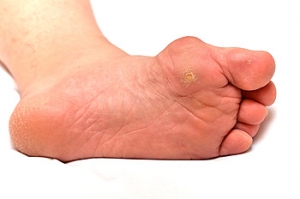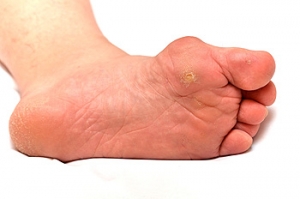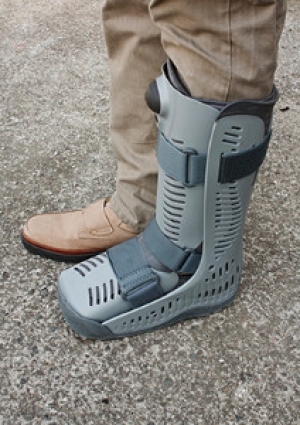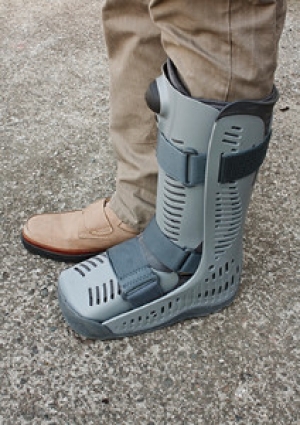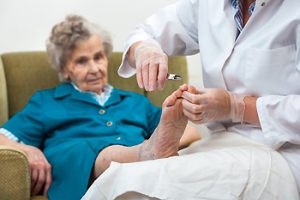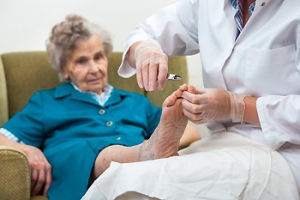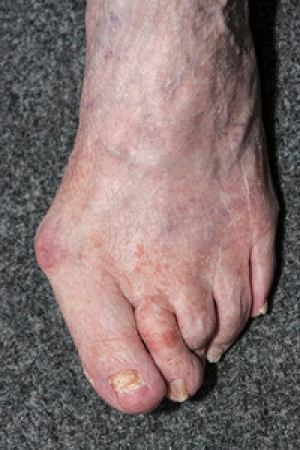Items filtered by date: January 2018
Causes of Corns
A small area of skin that appears thickened on the foot may be a condition referred to as a corn. The general reason behind the development of corns commonly revolves around shoes not fitting properly, therefore putting pressure on the feet. An example of this are high-heels, which typically squeeze the toes and cause friction. Corns can be painful and may affect the overall balance of the foot, often causing discomfort while walking or running. Treating the corn ideally involves removing the source of pressure and friction, allowing the foot to move with less constraint in the shoe. There are two types of corns that exist, and they can occur in different areas of the foot. Moisture that generates in between the toes may cause soft corns. Alternatively, hard corns are typically found on the pinky toe, caused by friction from ill-fitting shoes. If the corn becomes severe, a consultation with a podiatrist may be suggested for proper treatment of the condition.
If you have any concerns regarding your feet and ankles, contact Dr. Kenneth Donovan of Advanced Care Foot and Ankle. Our doctor will treat your foot and ankle needs.
Corns: What Are They? and How Do You Get Rid of Them?
Corns can be described as areas of the skin that have thickened to the point of becoming painful or irritating. They are often layers and layers of the skin that have become dry and rough, and are normally smaller than calluses.
Ways to Prevent Corns
There are many ways to get rid of painful corns such as wearing:
- Well-fitting socks
- Comfortable shoes that are not tight around your foot
- Shoes that offer support
Treating Corns
Treatment of corns involves removing the dead skin that has built up in the specific area of the foot. Consult with Our doctor to determine the best treatment option for your case of corns.
If you have any questions please feel free to contact one of our offices located in Warren, Livingston, and Toms River, NJ. We offer the newest diagnostic and treatment technologies for all your foot and ankle needs.
Read more about Corns: What Are They, and How Do You Get Rid of Them
Causes of Corns
 A small area of skin that appears thickened on the foot may be a condition referred to as a corn. The general reason behind the development of corns commonly revolves around shoes not fitting properly, therefore putting pressure on the feet. An example of this are high-heels, which typically squeeze the toes and cause friction. Corns can be painful and may affect the overall balance of the foot, often causing discomfort while walking or running. Treating the corn ideally involves removing the source of pressure and friction, allowing the foot to move with less constraint in the shoe. There are two types of corns that exist, and they can occur in different areas of the foot. Moisture that generates in between the toes may cause soft corns. Alternatively, hard corns are typically found on the pinky toe, caused by friction from ill-fitting shoes. If the corn becomes severe, a consultation with a podiatrist may be suggested for proper treatment of the condition.
A small area of skin that appears thickened on the foot may be a condition referred to as a corn. The general reason behind the development of corns commonly revolves around shoes not fitting properly, therefore putting pressure on the feet. An example of this are high-heels, which typically squeeze the toes and cause friction. Corns can be painful and may affect the overall balance of the foot, often causing discomfort while walking or running. Treating the corn ideally involves removing the source of pressure and friction, allowing the foot to move with less constraint in the shoe. There are two types of corns that exist, and they can occur in different areas of the foot. Moisture that generates in between the toes may cause soft corns. Alternatively, hard corns are typically found on the pinky toe, caused by friction from ill-fitting shoes. If the corn becomes severe, a consultation with a podiatrist may be suggested for proper treatment of the condition.
If you have any concerns regarding your feet and ankles, contact Dr. Kenneth Donovan of Advanced Care Foot and Ankle. Our doctor will treat your foot and ankle needs.
Corns: What Are They? and How Do You Get Rid of Them?
Corns can be described as areas of the skin that have thickened to the point of becoming painful or irritating. They are often layers and layers of the skin that have become dry and rough, and are normally smaller than calluses.
Ways to Prevent Corns
There are many ways to get rid of painful corns such as wearing:
- Well-fitting socks
- Comfortable shoes that are not tight around your foot
- Shoes that offer support
Treating Corns
Treatment of corns involves removing the dead skin that has built up in the specific area of the foot. Consult with Our doctor to determine the best treatment option for your case of corns.
If you have any questions please feel free to contact one of our offices located in Warren, Livingston, and Toms River, NJ . We offer the newest diagnostic and treatment technologies for all your foot and ankle needs.
Signs of a Broken Ankle
Severe pain, swelling and bruising on the foot may be indicative of a broken ankle. This typically occurs as a result from falling or from something heavy that has been dropped on the foot. Other evidence may include hearing a snapping noise coming from the foot at the time of injury or a dislocation occurring in the ankle, producing an odd shape. Applying an ice pack may numb the pain temporarily, and keeping it elevated will help the swelling dissipate. An x-ray is commonly taken to confirm the severity and presence of a broken ankle. Treatment may include having the foot in a cast or wearing a boot for more mobility. A podiatrist will make the determination depending on the extent of fracture. Utilizing crutches may be an option if it’s determined that any weight placed on the ankle is prohibited.
Broken ankles need immediate treatment. If you are seeking treatment, contact Dr. Kenneth Donovan from Advanced Care Foot and Ankle. Our doctor can provide the care you need to keep you pain-free and on your feet.
Broken Ankles
A broken ankle is experienced when a person fractures their tibia or fibula in the lower leg and ankle area. Both of these bones are attached at the bottom of the leg and combine to form what we know to be our ankle.
When a physician is referring to a break of the ankle, he or she is usually referring to a break in the area where the tibia and fibula are joined to create our ankle joint. Ankles are more prone to fractures because the ankle is an area that suffers a lot of pressure and stress. There are some obvious signs when a person experiences a fractured ankle, and the following symptoms may be present.
Symptoms of a Fractured Ankle
- Excessive pain when the area is touched or when any pressure is placed on the ankle
- Swelling around the area
- Bruising of the area
- Area appears to be deformed
If you suspect an ankle fracture, it is recommended to seek treatment as soon as possible. The sooner you have your podiatrist diagnose the fracture, the quicker you’ll be on the way towards recovery.
If you have any questions, please feel free to contact one of our offices located in Warren, Livingston, and Toms River, NJ. We offer the newest diagnostic and treatment technologies for all your foot care needs.
Signs of a Broken Ankle
 Severe pain, swelling and bruising on the foot may be indicative of a broken ankle. This typically occurs as a result from falling or from something heavy that has been dropped on the foot. Other evidence may include hearing a snapping noise coming from the foot at the time of injury or a dislocation occurring in the ankle, producing an odd shape. Applying an ice pack may numb the pain temporarily, and keeping it elevated will help the swelling dissipate. An x-ray is commonly taken to confirm the severity and presence of a broken ankle. Treatment may include having the foot in a cast or wearing a boot for more mobility. A podiatrist will make the determination depending on the extent of fracture. Utilizing crutches may be an option if it’s determined that any weight placed on the ankle is prohibited.
Severe pain, swelling and bruising on the foot may be indicative of a broken ankle. This typically occurs as a result from falling or from something heavy that has been dropped on the foot. Other evidence may include hearing a snapping noise coming from the foot at the time of injury or a dislocation occurring in the ankle, producing an odd shape. Applying an ice pack may numb the pain temporarily, and keeping it elevated will help the swelling dissipate. An x-ray is commonly taken to confirm the severity and presence of a broken ankle. Treatment may include having the foot in a cast or wearing a boot for more mobility. A podiatrist will make the determination depending on the extent of fracture. Utilizing crutches may be an option if it’s determined that any weight placed on the ankle is prohibited.
Broken ankles need immediate treatment. If you are seeking treatment, contact Dr. Kenneth Donovan from Advanced Care Foot and Ankle. Our doctor can provide the care you need to keep you pain-free and on your feet.
Broken Ankles
A broken ankle is experienced when a person fractures their tibia or fibula in the lower leg and ankle area. Both of these bones are attached at the bottom of the leg and combine to form what we know to be our ankle.
When a physician is referring to a break of the ankle, he or she is usually referring to a break in the area where the tibia and fibula are joined to create our ankle joint. Ankles are more prone to fractures because the ankle is an area that suffers a lot of pressure and stress. There are some obvious signs when a person experiences a fractured ankle, and the following symptoms may be present.
Symptoms of a Fractured Ankle
- Excessive pain when the area is touched or when any pressure is placed on the ankle
- Swelling around the area
- Bruising of the area
- Area appears to be deformed
If you suspect an ankle fracture, it is recommended to seek treatment as soon as possible. The sooner you have your podiatrist diagnose the fracture, the quicker you’ll be on the way towards recovery.
If you have any questions, please feel free to contact one of our offices located in Warren, Livingston, and Toms River, NJ . We offer the newest diagnostic and treatment technologies for all your foot care needs.
Reminder: When Was the Last Time…?
Custom orthotics, or shoe inserts, should be periodically replaced. Orthotics must fit properly to give you the best results. Protect your feet and ankles!
How Elderly Folks Can Maintain Proper Foot Conditions
As we age, the skin on our feet becomes thinner, potentially leading to foot infections, corns, and blisters. Difficulty in bending down and having poor eyesight can make it frustrating to trim the toenails. Caring for the feet may become easier when a regular foot routine is implemented. This may include cutting the toenails straight across, making sure the feet are clean and dry, and wearing shoes and socks that fit properly. The best time of day to shop for shoes is in the afternoon when the feet are at their biggest, so the fit will be comfortable all day. Typically, using a good moisturizer will not only feel good, but will be beneficial in helping to heal dry, cracked skin. It’s crucial to notice signs of infection, especially if diabetes is present, in addition to treating any form of toenail fungus that may exist. A consultation with a podiatrist may be suggested if foot pain and discomfort is experienced.
Everyday foot care is very important to prevent infection and other foot ailments. If you need your feet checked, contact Dr. Kenneth Donovan from Advanced Care Foot and Ankle. Our doctor can provide the care you need to keep you pain-free and on your feet.
Everyday Foot Care
Often, people take care of their bodies, face and hair more so than they do for their feet. But the feet are a very important aspect of our bodies, and one that we should pay more attention to. Without our feet, we would not be able to perform most daily tasks.
It is best to check your feet regularly to make sure there are no new bruises or cuts that you may not have noticed before. For dry feet, moisturizer can easily be a remedy and can be applied as often as necessary to the affected areas. Wearing shoes that fit well can also help you maintain good foot health, as well as making it easier to walk and do daily activities without the stress or pain of ill-fitting shoes, high heels, or even flip flops. Wearing clean socks with closed shoes is important to ensure that sweat and bacteria do not accumulate within the shoe. Clean socks help to prevent Athlete’s foot, fungi problems, bad odors, and can absorb sweat.
If you have any questions please feel free to contact one of our offices located in Warren, Livingston, and Toms River, NJ. We offer the newest diagnostic and treatment technologies for all your foot and ankle needs.
How Elderly Folks Can Maintain Proper Foot Conditions
 As we age, the skin on our feet becomes thinner, potentially leading to foot infections, corns, and blisters. Difficulty in bending down and having poor eyesight can make it frustrating to trim the toenails. Caring for the feet may become easier when a regular foot routine is implemented. This may include cutting the toenails straight across, making sure the feet are clean and dry, and wearing shoes and socks that fit properly. The best time of day to shop for shoes is in the afternoon when the feet are at their biggest, so the fit will be comfortable all day. Typically, using a good moisturizer will not only feel good, but will be beneficial in helping to heal dry, cracked skin. It’s crucial to notice signs of infection, especially if diabetes is present, in addition to treating any form of toenail fungus that may exist. A consultation with a podiatrist may be suggested if foot pain and discomfort is experienced.
As we age, the skin on our feet becomes thinner, potentially leading to foot infections, corns, and blisters. Difficulty in bending down and having poor eyesight can make it frustrating to trim the toenails. Caring for the feet may become easier when a regular foot routine is implemented. This may include cutting the toenails straight across, making sure the feet are clean and dry, and wearing shoes and socks that fit properly. The best time of day to shop for shoes is in the afternoon when the feet are at their biggest, so the fit will be comfortable all day. Typically, using a good moisturizer will not only feel good, but will be beneficial in helping to heal dry, cracked skin. It’s crucial to notice signs of infection, especially if diabetes is present, in addition to treating any form of toenail fungus that may exist. A consultation with a podiatrist may be suggested if foot pain and discomfort is experienced.
Everyday foot care is very important to prevent infection and other foot ailments. If you need your feet checked, contact Dr. Kenneth Donovan from Advanced Care Foot and Ankle. Our doctor can provide the care you need to keep you pain-free and on your feet.
Everyday Foot Care
Often, people take care of their bodies, face and hair more so than they do for their feet. But the feet are a very important aspect of our bodies, and one that we should pay more attention to. Without our feet, we would not be able to perform most daily tasks.
It is best to check your feet regularly to make sure there are no new bruises or cuts that you may not have noticed before. For dry feet, moisturizer can easily be a remedy and can be applied as often as necessary to the affected areas. Wearing shoes that fit well can also help you maintain good foot health, as well as making it easier to walk and do daily activities without the stress or pain of ill-fitting shoes, high heels, or even flip flops. Wearing clean socks with closed shoes is important to ensure that sweat and bacteria do not accumulate within the shoe. Clean socks help to prevent Athlete’s foot, fungi problems, bad odors, and can absorb sweat.
If you have any questions please feel free to contact one of our offices located in Warren, Livingston, and Toms River, NJ . We offer the newest diagnostic and treatment technologies for all your foot and ankle needs.
How Do I Treat My Bunion?
A large piece of bone protruding on the top or side of the foot may be referred to as a bunion. It’s often the result of inflammation of the tissues surrounding the big toe, in addition to the bones and tendons not lining up correctly. Narrow and high-heeled shoes are a common cause of bunions, which may become larger as time progresses and can possibly cause conditions like bursitis and arthritis. Symptoms can include tingling or numbness of the big toe, nerve irritation, and severe pain. Common bunions typically don’t require an exam, and most will be managed by applying cold therapy, wearing shoes with cushioned pads, and possibly taking anti-inflammatory medications. Surgery may be an option to consider if the pain is persistent or is affecting the quality of your life. A consultation with a podiatrist is advised for treatment of this condition.
If you are suffering from bunions, contact Dr. Kenneth Donovan of Advanced Care Foot and Ankle. Our doctor can provide the care you need to keep you pain-free and on your feet.
What Is a Bunion?
A bunion is formed of swollen tissue or an enlargement of boney growth, usually located at the base joint of the toe that connects to the foot. The swelling occurs due to the bones in the big toe shifting inward, which impacts the other toes of the foot. This causes the area around the base of the big toe to become inflamed and painful.
Why Do Bunions Form?
Genetics – Susceptibility to bunions are often hereditary
Stress on the feet – Poorly fitted and uncomfortable footwear that places stress on feet, such as heels, can worsen existing bunions
How Are Bunions Diagnosed?
Doctors often perform two tests – blood tests and x-rays – when trying to diagnose bunions, especially in the early stages of development. Blood tests help determine if the foot pain is being caused by something else, such as arthritis, while x-rays provide a clear picture of your bone structure to your doctor.
How Are Bunions Treated?
- Refrain from wearing heels or similar shoes that cause discomfort
- Select wider shoes that can provide more comfort and reduce pain
- Anti-inflammatory and pain management drugs
- Orthotics or foot inserts
- Surgery
If you have any questions, please feel free to contact one of our offices located in Warren, Livingston, and Toms River, NJ. We offer the newest diagnostic and treatment technologies for all your foot care needs.
How Do I Treat My Bunion?
 A large piece of bone protruding on the top or side of the foot may be referred to as a bunion. It’s often the result of inflammation of the tissues surrounding the big toe, in addition to the bones and tendons not lining up correctly. Narrow and high-heeled shoes are a common cause of bunions, which may become larger as time progresses and can possibly cause conditions like bursitis and arthritis. Symptoms can include tingling or numbness of the big toe, nerve irritation, and severe pain. Common bunions typically don’t require an exam, and most will be managed by applying cold therapy, wearing shoes with cushioned pads, and possibly taking anti-inflammatory medications. Surgery may be an option to consider if the pain is persistent or is affecting the quality of your life. A consultation with a podiatrist is advised for treatment of this condition.
A large piece of bone protruding on the top or side of the foot may be referred to as a bunion. It’s often the result of inflammation of the tissues surrounding the big toe, in addition to the bones and tendons not lining up correctly. Narrow and high-heeled shoes are a common cause of bunions, which may become larger as time progresses and can possibly cause conditions like bursitis and arthritis. Symptoms can include tingling or numbness of the big toe, nerve irritation, and severe pain. Common bunions typically don’t require an exam, and most will be managed by applying cold therapy, wearing shoes with cushioned pads, and possibly taking anti-inflammatory medications. Surgery may be an option to consider if the pain is persistent or is affecting the quality of your life. A consultation with a podiatrist is advised for treatment of this condition.
If you are suffering from bunions, contact Dr. Kenneth Donovan of Advanced Care Foot and Ankle. Our doctor can provide the care you need to keep you pain-free and on your feet.
What Is a Bunion?
A bunion is formed of swollen tissue or an enlargement of boney growth, usually located at the base joint of the toe that connects to the foot. The swelling occurs due to the bones in the big toe shifting inward, which impacts the other toes of the foot. This causes the area around the base of the big toe to become inflamed and painful.
Why Do Bunions Form?
Genetics – Susceptibility to bunions are often hereditary
Stress on the feet – Poorly fitted and uncomfortable footwear that places stress on feet, such as heels, can worsen existing bunions
How Are Bunions Diagnosed?
Doctors often perform two tests – blood tests and x-rays – when trying to diagnose bunions, especially in the early stages of development. Blood tests help determine if the foot pain is being caused by something else, such as arthritis, while x-rays provide a clear picture of your bone structure to your doctor.
How Are Bunions Treated?
- Refrain from wearing heels or similar shoes that cause discomfort
- Select wider shoes that can provide more comfort and reduce pain
- Anti-inflammatory and pain management drugs
- Orthotics or foot inserts
- Surgery
If you have any questions, please feel free to contact one of our offices located in Warren, Livingston, and Toms River, NJ . We offer the newest diagnostic and treatment technologies for all your foot care needs.
